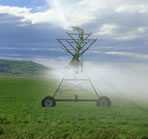Types of Agricultural Water Use
Irrigation vs. Rain-Fed Agriculture
There are two main ways that farmers and ranchers use agricultural water to cultivate crops:
- Rain-fed farming
- Irrigation
Rain-fed farming is the natural application of water to the soil through direct rainfall. Relying on rainfall is less likely to result in contamination of food products but is open to water shortages when rainfall is reduced. On the other hand, artificial applications of water increase the risk of contamination.

Irrigation is the artificial application of water to the soil through various systems of tubes, pumps, and sprays. Irrigation is usually used in areas where rainfall is irregular or dry times or drought is expected. There are many types of irrigation systems, in which water is supplied to the entire field uniformly. Irrigation water can come from groundwater, through springs or wells, surface water, through rivers, lakes, or reservoirs, or even other sources, such as treated wastewater or desalinated water. As a result, it is critical that farmers protect their agricultural water source to minimize the potential for contamination. As with any groundwater removal, users of irrigation water need to be careful in not pumping groundwater out of an aquifer faster than it is being recharged.
Types of Irrigation Systems
There are many different types of irrigation systems, depending on how the water is distributed throughout the field. Some common types of irrigation systems include:
Surface irrigation
Water is distributed over and across land by gravity, no mechanical pump involved.
Localized irrigation
Water is distributed under low pressure, through a piped network and applied to each plant.
Drip irrigation
A type of localized irrigation in which drops of water are delivered at or near the root of plants. In this type of irrigation, evaporation and runoff are minimized.
Sprinkler irrigation
Water is distributed by overhead high-pressure sprinklers or guns from a central location in the field or from sprinklers on moving platforms.
Center pivot irrigation
Water is distributed by a system of sprinklers that move on wheeled towers in a circular pattern. This system is common in flat areas of the United States.
Lateral move irrigation
Water is distributed through a series of pipes, each with a wheel and a set of sprinklers, which are rotated either by hand or with a purpose-built mechanism. The sprinklers move a certain distance across the field and then need to have the water hose reconnected for the next distance. This system tends to be less expensive but requires more labor than others.
Sub-irrigation
Water is distributed across land by raising the water table, through a system of pumping stations, canals, gates, and ditches. This type of irrigation is most effective in areas with high water tables.
Manual irrigation
Water is distributed across land through manual labor and watering cans. This system is very labor intensive.
For more information on types of irrigation, visit the United States Geological Survey’s (USGS) Irrigation Methods page.
- Page last reviewed: October 11, 2016
- Page last updated: October 11, 2016
- Content source:


 ShareCompartir
ShareCompartir